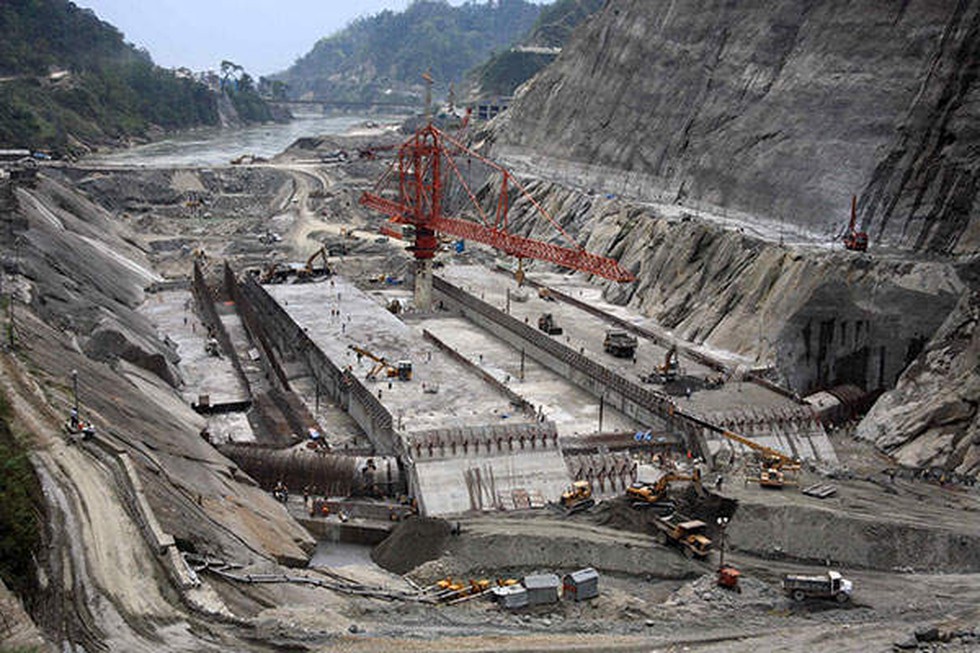
About Subansiri Lower Hydro Electric Project (SLHEP):
- It is an under-construction gravity dam on the Subansiri River in North Eastern India on the borders of Arunachal Pradesh and Assam.
- It is a run-of-river project.
- It will be the single largest hydroelectric plant in India when completed.
- The project is being developed by the state-run National Hydro Power Corporation (NHPC).
- It is expected to supply 2,000 MW of power (eight 250 MW units) when completed.
Key Facts about Subansiri River:
- It is a trans-Himalayan River and a right-bank tributary of the Brahmaputra River.
- Also called the Gold River, the Subansiri River is famous for its gold dust.
- Course:
- It originates from the Himalayas in China and flows towards the east and southeast into India.
- It flows through Assam, Arunachal Pradesh,and the Tibet Autonomous Region of China.
- It joins the Brahmaputra River in the Lakhimpur district of Assam.
- It is approx. 518 km long, with a drainage basin of 32,640 s km.
- It is the largest tributary of the Brahmaputra, contributing 7.92% of the Brahmaputra's total flow.
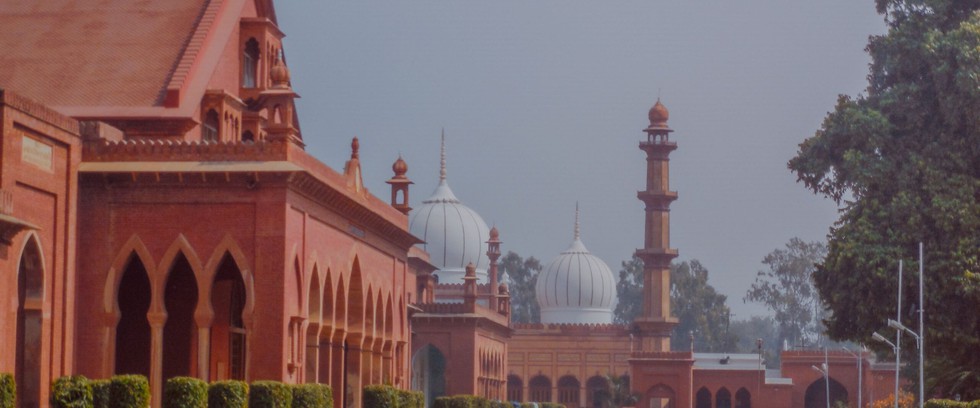
About Aligarh Muslim University:
- It is a government-run education institution situated in Aligarh, Uttar Pradesh.
- History:
- It was originally established by social reformer Sir Syed Ahmad Khan as the Mohammedan Anglo-Oriental College in 1875.
- In the aftermath of the 1857 Indian War of Independence, the College was built on Khan’s conviction that it was important for Muslims to gain education and become involved in public life and government services in India.
- Raja Jai Kishan helped Sir Syed establish the college.
- Muhammadan Anglo-Oriental College became AMU in 1920, following the Aligarh Muslim University Act.
- From its very inception, it has kept its door open to members of all communities and from all corners of the country and the world.
- The university is open to all irrespective of caste, creed, religion, or gender.
- AMU is recognised by the University Grant Commission (UGC) and the Association of Indian Universities (AIU).
- AMU offers more than 300 courses in the traditional and modern branches of education.
- It draws students from all states in India and from different countries, especially Africa, West Asia, and Southeast Asia.
- In some courses, seats are reserved for students from SAARC and Commonwealth Countries.
- It has three off-campus centres: AMU Malappuram Campus (Kerala), AMU Murshidabad Centre (West Bengal), and Kishanganj Centre (Bihar).
Minority Status of AMU:
- In 1967, a five-judge Constitution bench in the Azeez Basha vs. Union of India case held that since AMU was a central university, it could not be considered a minority institution.
- AMU got back its minority status when Parliament passed the AMU (Amendment) Act in 1981.
- In January 2006, the Allahabad High Court struck down the provision of the 1981 law by which AMU was accorded the minority status.
- Later, appeals were filed in the Supreme Court challenging the high court verdict.
- On January 9, 2024, a seven-judge bench of the Supreme Court commenced hearing arguments on the vexed question of minority status of AMU.
- It overruled judgement in the 1967 Azeez Basha case and also said that a new bench would decide on the minority status of the AMU.
- The judgement underlined the importance of identifying the university's actual point of origin-its genesis-to establish its minority status.
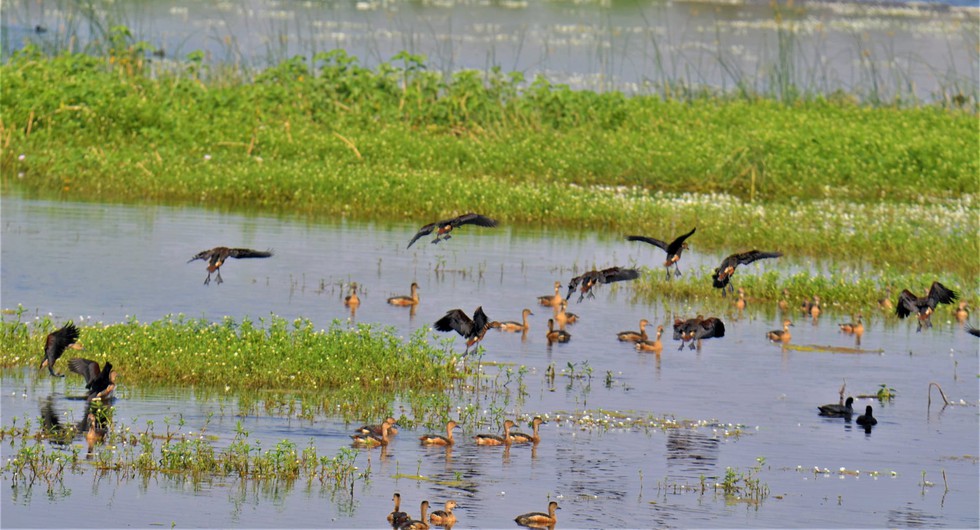
About Sirpur Lake:
- It is a human-made wetlandlocated in Indore, Madhya Pradesh.
- It is a 670-acre lake, which is more than 130 years old, made by Maharaja Shivajirao Holkar to generate water supply for the city of Indore.
- The Indore City Gazette, 1908, has many references to Sirpur Lake, utilised for water supply and recreational purposes.
- It is a shallow, alkaline, nutrient-rich lake that floods during the monsoon.
- Sirpur Lake boasts a diverse habitat, featuring extensive wetlands, shrub forests, grasslands, tall trees, and shallow and deep-water areas.
- Fauna:
- It is inhabited by 189 species of birds, belonging to 55 families.
- It is arguably one of the only remaining birdwatching sites where water birds can be recorded within city limits.
- Commonly sighted species include the painted stork, bar-headed goose, Eurasian wigeon, and several species of egrets, herons, and kingfishers.
- It is also home to several species of reptiles, insects, butterflies, and fish.
- It was designated a Ramsar site under the Ramsar Convention on January 7, 2022.

About Toxic Epidermal Necrolysis (TEN):
- TEN, also known as Lyell's syndrome, is a rare, life-threatening skin condition.
- TEN is the most severe form of Stevens-Johnson syndrome (SJS).
- Both conditions are caused by a reaction to medications-often antibiotics or anticonvulsives.
- People with weakened immune systems are more likely to develop SJS or TEN.
- Symptoms may include:
- A painful, red area that spreads quickly
- The skin may peel without blistering
- Raw areas of skin
- Discomfort
- Fever
- Condition spread to eyes, mouth/throat, and genitals/urethra/anus
- TEN causes large areas of blistering and peeling skin on at least 30% of your body, including mucous membranes like the mouth, eyes and genitals.
- Because the skin normally acts as a protective barrier, extensive skin damage can lead to a dangerous loss of fluids and allow infections to develop.
- Serious complications can include pneumonia, overwhelming bacterial infections (sepsis), shock, multiple organ failure, and death.
- It has a mortality rate of approximately 30 percent.
- Treatment:
- TEN requires emergency medical treatment at a hospital.
- If a medicine is causing the skin reaction, it is discontinued.
- While the skin heals, supportive care includes controlling pain, caring for wounds and making sure you're getting enough fluids.
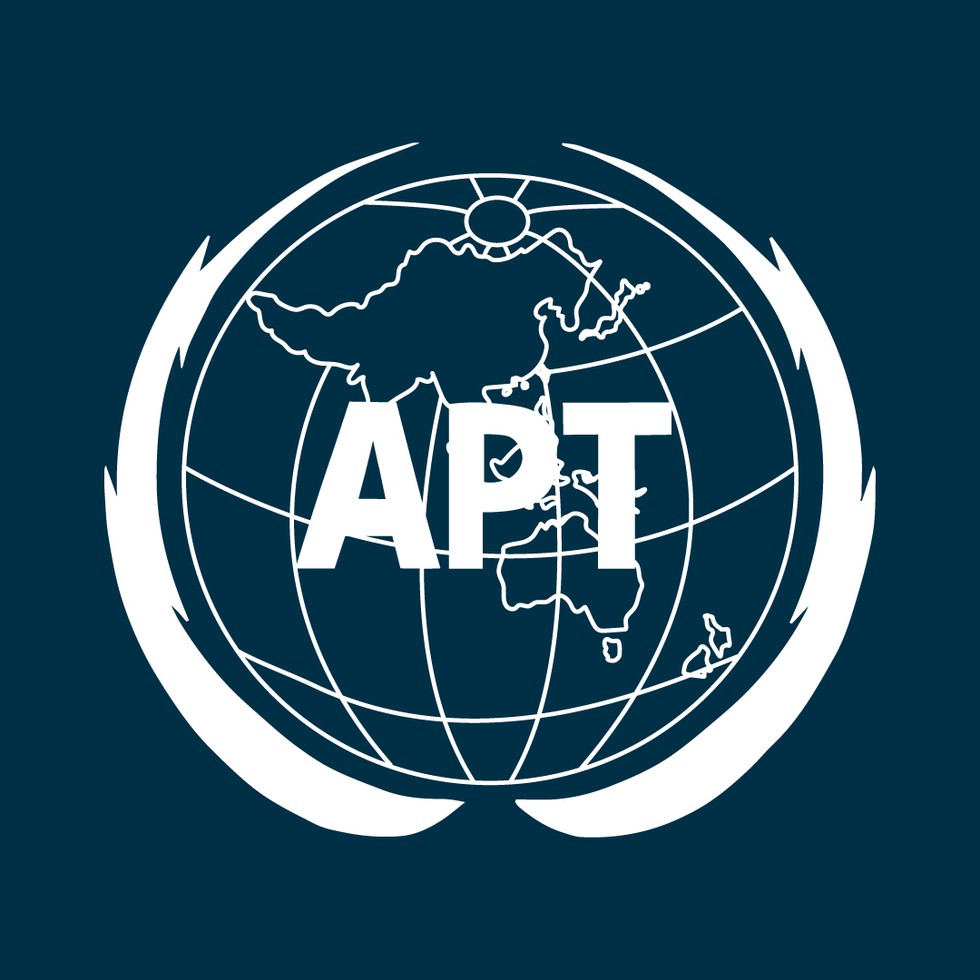
About Asia-Pacific Tele community (APT):
- APT is an intergovernmental organization established in February 1979 to promote Information and Communication Technology (ICT) development in the Asia-Pacific region.
- APT was founded on the joint initiatives of the United Nations Economic and Social Commission for Asia and the Pacific (UNESCAP) and the International Telecommunication Union (ITU).
- Currently, the APT has a strength of 38 Members, 4 Associate Members and more than 140 Affiliate Members (private companies and academia whose works are relevant to the ICT field).
- Functions:
- APT fosters the development of telecommunication servicesand information infrastructure throughout the region.
- It plays a crucial role in coordinating and harmonizing policies, regulations, and technical standards related to ICT.
- APT conducts various preparatory activities for international conferences, including the ITU Plenipotentiary Conference (PP), World Radiocommunication Conferences (WRCs), World Telecommunication Standardization Assemblies (WTSAs), World Summit on the Information Society (WSIS), and World Telecommunication Development Conferences (WTDCs).
- The organization also hosts working groups and forums to address specific issues such as spectrum management, policy, and standardization.
- APT also organizes a variety of capacity-building programs related to ICT topics and implements several pilot projects to promote ICT development in the region.
- In addition, APT provides sub-regional platforms to facilitate achieving sub-regional common interests.
- For example, the South Asian Telecommunication Regulators’ Council (SATRC), under the umbrella of APT, organizes working groups for policy and regulation, and spectrum to facilitate harmonization among parties concerned.
- The SATRC meeting is an annual event where heads of telecommunication regulatory bodies from SATRC member countries discuss and coordinate regulatory and other issues related to telecommunication and ICT.
- SATRC is composed of the heads of the regulatory bodies of nine South Asian countries, namely, Afghanistan, Bangladesh, Bhutan, India, Iran, Maldives, Nepal, Pakistan, and Sri Lanka.
- Affiliate members from these countries are also taking active participation in SATRC activities.

About Exercise Antariksha Abhyas:
- It is an exercise to war-game the growing threats from and to Space-Based Assets and Services
- It is being conducted by the Defence Space Agency of Headquarters Integrated Defence Staff.
- It is a first of its kind exercise being conducted and is expected to help secure national strategic objectives in space and integrate India’s space capability in military operations.
- It aims to provide enhanced understanding of space based assets and services and to gain understanding of operational dependency on space segment between stakeholders.
- In addition, it intends to identify vulnerabilities in conduct of operations in the event of denial or disruptions of space based services.
- It will have participants from the Defence Space Agency and its allied units along with personnel from the Army, Navy and the Air Force. Specialist branches under Headquarters Integrated Defence Staff viz Defence Cyber Agency, Defence Intelligence Agency and Strategic Forces Command would also be active participants in conduct of the exercise.
- Representatives from Indian Space Research Organisation and the Defence Research & Development Organisation will also take part in it.

About Gluten:
- It is a protein found in the wheat plant and some other grains.
- Many cereal grains — but in particular barley, wheat, and rye — contain specific proteins that, when mixed with water and kneaded, create an elastic mass.
- Two important types of these proteins are gliadins and glutenins. At the microscopic level, gluten is an elastic mesh of the protein molecules.
- It is naturally occurring, but it can be extracted, concentrated and added to food and other products to add protein, texture and flavor.
- It also works as a binding agent to hold processed foods together and give them shape.
- It allows the dough to rise and gives it its chewy character.
- The ability of gliadins and glutenins to create gluten makes them prized ingredients in the food industry.
- Issues of Gluten
- An enzyme called protease helps digest proteins but it cannot break down gluten. When such gluten reaches the small intestine, the body can develop gastrointestinal problems.
- Coeliac disease: It’s characterised by a severe allergic reaction in the small intestine, prompting the immune system to produce a large number of antibodies that attack the body’s own proteins. The disease is present in around 2% of the general population.
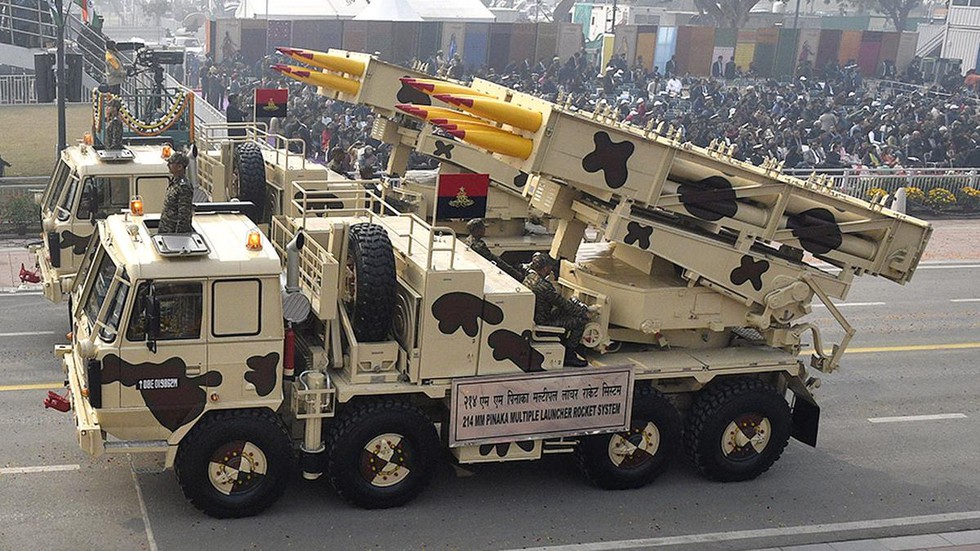
About Pinaka Multi-Barrel Rocket Launcher:
- It is designed by the Armament Research and Development Establishment (ARDE), a laboratory of the DRDO.
- It was first used during the Kargil War, where it successfully neutralised Pakistan Army positions on the mountain tops.
- It delivers lethal and responsive fire against a variety of area targets, such as exposed enemy troops, armoured and soft-skin vehicles, communication centres, air terminal complexes, and fuel and ammunition dumps.
- Features:
- It consists of a multi-tube launcher vehicle, a replenishment-cum-loader vehicle, a replenishment vehicle, and a command post vehicle.
- The rocket launcher has two pods containing six rockets each and can neutralise an area of 700 × 500 square metres within 48 seconds.
- The launcher system is supported on four hydraulically-actuated outriggers at the time of firing.
- Range: It has a range of 60 to 75 kilometers.
- The system is mounted on a Tatra truck for mobility.
- Its success has already extended beyond India's borders, with countries like Armenia placing orders, and many others expressing interest in acquiring the system.
- It is suitable for different types of military engagements, such as counter-terrorism, border defence and conventional warfare.
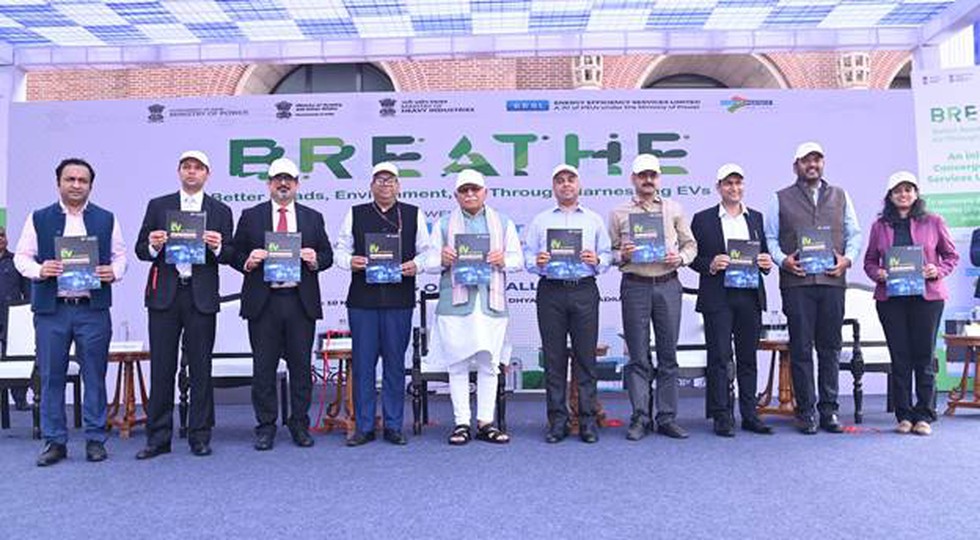
About 'EV as a Service' Programme:
- It aims to boost e-mobility in government offices; to deploy 5,000 E-Cars in government departments over the next two years.
- It is an initiative of Convergence Energy Services Limited (CESL), a subsidiary of Energy Efficiency Services Limited (EESL).
- By leveraging a flexible procurement model, the programme allows for the deployment of a variety of E-Car makes/models, enabling Govt. offices to choose E-Cars that best align with their operational requirements.
- It may be noted that CESL has already deployed nearly 2000 nos. of E-Cars across India and is also facilitating the deployment of approx. 17,000 E-Buses.
- It not only supports the government’s environmental sustainability vision but also aligns with India’s ambitious goal of achieving net zero emissions by 2070.
What is CESL?
- It is a newly established subsidiary of state-owned Energy Efficiency Services Limited, itself a joint venture of public sector companies under the Ministry of Power, Government of India.
- It builds upon the decentralized solar development experience in under-served rural communities in India, and over time, using battery energy storage, will deliver renewable energy solutions to power agricultural pumps, street lighting, domestic lighting and cooking appliances in villages.
- CESL will also work to enable battery-powered electric mobility and its infrastructure and design business models to increase the uptake of electric vehicles in India.
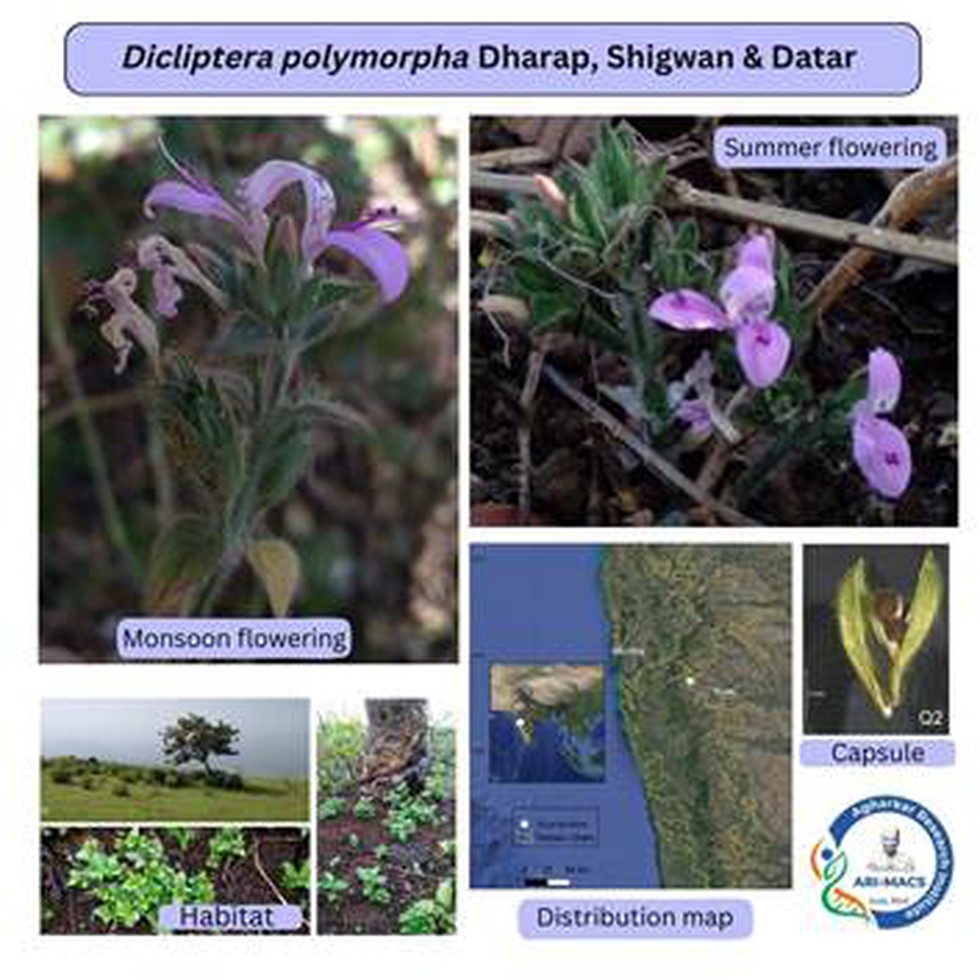
About Dicliptera Polymorpha:
- It is a distinctive species, notable for its fire-resilient, pyrophytic habit and its unusual dual-blooming pattern.
- In addition to its typical post-monsoon flowering, the species exhibits a second, vigorous burst of flowering triggered by the grassland fires commonly set by locals in the region.
- This species is taxonomically unique, with inflorescence units (cymules) that develop into spicate inflorescences.
- It is the only known Indian species with this spicate inflorescence structure, with its closest allied being found in Africa.
- The species was named Dicliptera polymorpha to reflect its diverse morphological traits.
- It thrives on slopes in open grasslands of the northern Western Ghats, an area exposed to extreme climatic conditions such as summer droughts and frequent human-induced fires. Despite these harsh conditions, the species has adapted to survive and bloom twice a year.
- The first flowering phase occurs from post-monsoon (early November) to March or April, while the second flowering phase in May and June is triggered by fires.
- During this second phase, the woody rootstocks produce dwarf flowering shoots, leading to a more abundant but shorter flowering period.
- The species' unique adaptation to fire and its limited habitat range in the Western Ghats highlight the need for careful management of grassland ecosystems.


























































































































































.png)
.png)
.png)
.png)
.png)


.png)
.png)
.png)





.png)
.png)






.png)
.png)
.png)
.png)
.png)
.png)
.png)
.png)
.png)

.png)







.png)
.png)


.png)
.png)
.png)


.png)

.png)
.png)





.jpg)

.png)
.png)


.png)

.png)
.png)
.png)

.jpg)

.jpg)


.png)

.png)
.png)
.png)
.png)
.png)
.png)
.png)
.png)
.png)
.png)




.png)

.png)





.png)
.png)
.png)
.png)
.png)
.png)
.png)
.png)
.png)
.png)
.jpg)
.jpg)

.png)
.png)
.png)
.png)
.png)
.png)
.png)
.png)
.png)
.png)
.png)
.png)
.png)
.png)
.png)
.png)
.png)
.png)
.png)
.png)
.png)
.png)



.png)
.png)

.jpg)
.jpg)


.jpg)
.jpg)
.jpg)
.jpg)
.jpg)

.jpg)








.jpg)
.jpg)
.jpg)
.jpg)
.jpg)

















.jpg)
.jpg)







.jpg)


















.jpg)
.jpg)






























































































.jpg)
.jpg)


























.jpg)

.jpg)










.jpg)








.jpg)




.jpg)










.jpg)


















.jpg)












































.jpg)














.jpg)
.jpg)
.jpg)





.jpg)

.jpg)
.jpg)





































































.jpg)


































.jpg)
.jpg)
















































.jpg)












.jpg)


.jpg)




.jpg)
.jpg)
.jpg)

.jpg)
.jpg)
.jpg)
.jpg)

.jpg)
.jpg)
.jpg)

.jpg)
.jpg)
.jpg)
.jpg)
.jpg)
.jpg)
.jpg)
.jpg)

.jpg)


.jpg)
.jpg)
.jpg)
.jpg)
.jpg)
.jpg)
.jpg)
.jpg)
.jpg)
.jpg)











.jpg)
.jpg)





.jpg)
.jpg)
.jpg)
























.jpg)
























.jpg)









.jpg)
.jpg)







.jpg)
.jpg)









































.jpg)
.jpg)
.jpg)
.jpg)
.jpg)

.jpg)
.jpg)
.jpg)
.jpg)
.jpg)


.jpg)
.jpg)
.jpg)
.jpg)
.jpg)

.jpg)
.jpg)
.jpg)
.jpg)
.jpg)
.jpg)
.jpg)
.jpg)
.jpg)
.jpg)
.png)

.png)
.png)

.png)
.png)
.png)
.png)


.jpg)
.jpg)

.jpg)
.jpg)
.jpg)

.png)
.png)
.png)
.png)
.png)
.png)
.png)

.png)
.png)
.png)
.png)
.png)
.png)
.png)
.png)
.png)
.png)





































































-min.png)



.png)




.png)








































